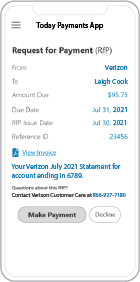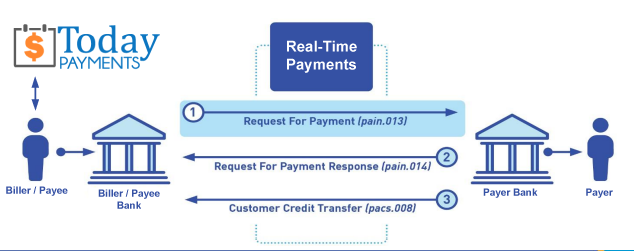
Recurring Payment Scheduling with Request for Payments (RfP) via FedNow® & RTP®
To modernize recurring billing and payment collection by enabling scheduled Requests for Payments (RfPs) via real-time FedNow® and RTP® rails, delivering instant, irrevocable funds through account-to-account (A2A) transactions and empowering merchants with true billing automation.
TodayPayments.com empowers merchants to automate recurring payments with scheduled RfPs over FedNow® and RTP®, transforming manual invoicing into a real-time, good funds guarantee. We simplify autopay for both businesses and consumers, eliminating delays and creating a “set it and forget it” recurring billing environment built for speed, security, and cash flow certainty.
Recurring billing has long been plagued by credit card declines, ACH delays, and operational inefficiencies. But a new payment model is here. With FedNow® and RTP®, businesses can now initiate Scheduled Recurring Payments via Request for Payment (RfP) messaging—collecting good funds instantly and automatically, using the power of real-time A2A debit rails.
No more chasing late invoices. No more reconfirming each bill. Just one-time payer authorization, and your revenue flows in like clockwork.
A Scheduled Request for Payment (RfP) allows merchants to collect funds on recurring intervals without requiring manual payer approvals each time. Once the payer provides a standing authorization, future RfPs are auto-approved and executed on schedule.
Key Benefits:
- Seamless autopay setup for recurring subscriptions, memberships, insurance, utilities
- Supports variable amounts or fixed recurring invoices
- Instant settlement of good funds—no returns, no chargebacks
- Customer experience optimized for mobile, POS, MOTO, and eCommerce
Enable “Set It and Forget It” Autopay Using Standing Authorization
Using FedNow® or RTP®, a scheduled RfP:
- Is sent on a predefined billing cycle
- Pulls funds from payer’s account instantly once due
- Uses bank alias, email, or phone number—no need to share sensitive banking info
- Ensures instant confirmation of payment success
- Provides rich remittance data in ISO 20022 format for accounting and reconciliation
This makes real-time payments an ideal alternative to ACH and credit card billing for high-volume recurring merchants.
How It Works: A2A Debit Transactions with Real-Time Rails

Using FedNow® or RTP®, a scheduled RfP:
- Is sent on a predefined billing cycle
- Pulls funds from payer’s account instantly once due
- Uses bank alias, email, or phone number—no need to share sensitive banking info
- Ensures instant confirmation of payment success
- Provides rich remittance data in ISO 20022 format for accounting and reconciliation
This makes real-time payments an ideal alternative to ACH and credit card billing for high-volume recurring merchants.
Itemized Parameters, Attributes, Benefits, and Features of Real-Time Scheduled RfPs
|
Category |
Details |
|
Transaction Method |
Real-Time A2A Debit (FedNow®, RTP®) |
|
Payment Initiation |
|
|
Payer Authorization |
Standing Approval (one-time setup for recurring billing) |
|
Speed & Settlement |
Real-Time, Irrevocable, Good Funds |
|
Use Case Types |
C2B, B2B, Recurring Billing, Subscriptions, Usage-Based Invoicing |
|
Merchant Interfaces |
POS, MOTO, Hosted Payment Pages, eCommerce |
|
Data Format Support |
ISO 20022, JSON, CSV |
|
Security & Privacy |
Alias-based (email/phone), Bank-level Encryption |
|
Customer Experience |
"Set it and forget it" autopay flow, mobile and SMS friendly |
|
Integration Capability |
Seamless integration into QuickBooks®, ERPs, CRMs |
Ask us How:
- Set up scheduled recurring payments using FedNow® and RTP® real-time debit rails and receive instant, irrevocable funds.
- Empower automated billing using Request for Payment (RfP™) technology—perfect for C2B and B2B recurring invoices.
- Improve cash flow with "set it and forget it" autopay, enabled by standing authorization over secure A2A transactions.
- Eliminate credit card failures and ACH delays by using Scheduled RfPs over FedNow® and RTP®.
- Use rich ISO 20022 payment messaging to reconcile scheduled recurring billing automatically across systems.
- Perfect for merchants billing weekly, monthly, or usage-based subscriptions who want instant settlement without payer friction.
Creating a recurring invoice using a digital Request for Payment (RfP) involves several key elements to ensure accuracy, efficiency, and convenience for both the payer and the payee. Here are the essential elements:
1. Payer Information: Include accurate details about the payer, such as their name, address, contact information, and any relevant identification numbers or account references.
2. Payee Information: Provide detailed information about the payee, including their name, business name (if applicable), address, contact information, and any identification numbers or account references necessary for payment processing.
3. Invoice Details: Clearly outline the invoice details, including the invoice number, issue date, due date, payment terms, and any applicable discounts or late fees. This information helps the payer understand the invoice requirements and payment expectations.
4. Itemized Charges: List all goods or services provided, along with their corresponding quantities, unit prices, and total amounts. This itemization ensures transparency and accuracy in billing, allowing the payer to review the charges and reconcile them with the provided goods or services.
5. Payment Amount: Specify the total amount due for the invoice, including any taxes, fees, or additional charges. Clearly indicate the currency in which the payment should be made to avoid confusion.
6. Payment Instructions: Provide clear instructions on how the payer can make the payment, including accepted payment methods (e.g., bank transfer, credit card, digital wallets), payment deadlines, and any required payment references or codes.
7. Recurring Payment Schedule: Clearly define the recurring payment schedule, including the frequency (e.g., monthly, quarterly, annually), start date, end date (if applicable), and the total number of recurring payments. This information ensures that both parties understand the payment schedule and expectations.
8. Authorization: Include language indicating that the payer authorizes the payee to initiate recurring payments according to the specified schedule. This authorization should be clear and explicit, outlining the terms and conditions of the recurring payment arrangement.
9. Terms and Conditions: Provide comprehensive terms and conditions governing the recurring payment arrangement, including cancellation policies, late payment penalties, dispute resolution procedures, and any other relevant terms. This ensures that both parties are aware of their rights and obligations regarding recurring payments.
10. Compliance and Legal Requirements: Ensure that the recurring invoice complies with all applicable legal and regulatory requirements, including tax laws, consumer protection regulations, and data privacy laws. Adherence to these requirements helps mitigate legal risks and ensures compliance with industry standards.
By incorporating these elements into a recurring invoice using a digital Request for Payment, businesses can streamline the invoicing process, improve payment accuracy, and enhance the overall payment experience for both parties involved.
Real-Time Autopay for Recurring Revenue Starts Here
Recurring revenue should be automatic, fast, and frictionless. With TodayPayments.com, you can finally collect scheduled recurring payments using real-time RfPs—with no delays, no approvals for each bill, and no credit card surprises.
Customers love the “set it and forget it” experience. Merchants love the real-time certainty of good funds. And your accounting team will love how easy it is to track, reconcile, and scale recurring billing.
👉 Start your journey at https://www.TodayPayments.com and bring the future of scheduled real-time billing to your business—today.
Creation Recurring Request for Payment
We were years ahead of competitors recognizing the benefits of RequestForPayment.com. We are not a Bank. Our function as a role as an "Accounting System" in Open Banking with Real-TimePayments.com to work with Billers to create the Request for Payment to upload the Biller's Bank online platform. Today Payments' ISO 20022 Payment Initiation (PAIN .013) shows how to implement Create Real-Time Payments Request for Payment File up front delivering a message from the Creditor (Payee) to it's bank. Most banks (FIs) will deliver the message Import and Batch files for their company depositors for both FedNow and Real-Time Payments (RtP). Once uploaded correctly, the Creditor's (Payee's) bank continues through a "Payment Hub", either FedNow or RTP, will be the RtP Hub will be The Clearing House, with messaging to the Debtor's (Payer's) bank.

ACH and both Instant and Real-Time Payments Request for Payment
ISO 20022 XML Message Versions
The versions that
NACHA recommends for the Request for Payment message and the Response to the Request are pain.013 and pain.014
respectively. Version 5 for the RfP messages, which
The Clearing House Real-Time Payments system has implemented, may also be utilized as
there is no material difference in the schemas. Predictability, that the U.S. Federal Reserve, via the
FedNow ® Instant Payments, will also use Request for Payment. The ACH, RTP ® and FedNow ® versions are Credit Push Payments.
Payees ensure the finality of Instant Real-Time
Payments (IRTP) and FedNow using recurring Requests for
Payments (RfP), Payees can implement certain measures:
1.
Confirmation Mechanism:
Implement a confirmation mechanism to ensure that each
payment request is acknowledged and confirmed by the payer
before the payment is initiated. This can include requiring
the payer to provide explicit consent or authorization for
each recurring payment.
2.
Transaction Monitoring:
Continuously monitor the status of recurring payment
requests and transactions in real-time to detect any
anomalies or discrepancies. Promptly investigate and resolve
any issues that arise to ensure the integrity and finality
of payments.
3.
Authentication and
Authorization: Implement strong
authentication and authorization measures to verify the
identity of the payer and ensure that only authorized
payments are processed. This can include multi-factor
authentication, biometric verification, or secure
tokenization techniques.
4.
Payment Reconciliation:
Regularly reconcile payment transactions to ensure that all
authorized payments have been successfully processed and
finalized. This involves comparing transaction records with
payment requests to identify any discrepancies or
unauthorized transactions.
5.
Secure Communication Channels:
Utilize secure communication channels, such as encrypted
messaging protocols or secure APIs, to transmit payment
requests and transaction data between the payee and the
payer. This helps prevent unauthorized access or
interception of sensitive payment information.
6.
Compliance with Regulatory
Standards: Ensure compliance with
relevant regulatory standards and guidelines governing
instant payments and recurring payment transactions. This
includes adhering to data security requirements, fraud
prevention measures, and consumer protection regulations.
By implementing these measures, Payees can enhance
the finality and security of Instant Real-Time Payments
using recurring Requests for Payments, thereby minimizing
the risk of payment disputes, fraud, or unauthorized
transactions.
Each day, thousands of businesses around the country are turning their transactions into profit with real-time payment solutions like ours.

Contact Us for Request For Payment payment processing

